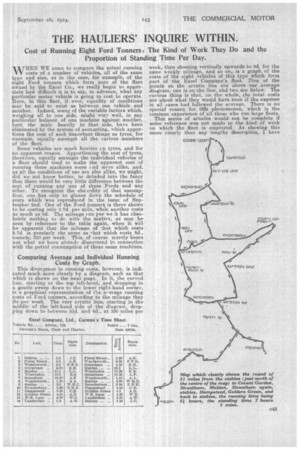THE HAULIERS' INQUIRE WITHIN.
Page 23

Page 24

If you've noticed an error in this article please click here to report it so we can fix it.
Cost of Running Eight Ford Tonners : The Kind of Work They Do and the Proportion of Standing Time Per Day.
WHEN WE come to compare the actual running costs of a number of vehicles, all of the same type and size, as in the case, for example, of the eight Ford tonners which form part of the fleet owned by the Excel Co., we really begin to appreciate how difficult it is to say, in advance, what any particular motor vehicle is going to cost to operate. Here, in this fleet, if ever, equality of conditions may be said to exist as between one vehicle and another. indeed, many of the variable factors which, weighing all to one side, might ver.7 well, in any particular balance of one machine against another, turn the scale heavily to that side, have been eliminated by the system of accounting, which apportions the cost of such important things as tyres, for example, equally amongst all the various members of the fleet.
Some 'vehicles are much heavier en tyres, and for no apparent reason. Apportioning the cost of tyres, therefore, equally amongst the individual vehicles of a fleet should tend to make the apparent cost of running those machines more ;nil inPre alike, and, as all the conditions of use are also alike, we might, did we not know better, he deluded into the fancy that there would be very little difference between the cost of running any one of these Fords and any other. To recognize the absurdity of that assumption, one has only to glance down the schedule of costs which was reproduced in the issue of September 2nd. One of the Ford tonners is there shown to be costing only 5.7d. per mile, while another costs as much as 8d. The mileage run rer e A: has thsoIutely nothing to do with the matter, as may be seen by reference to the table again, when it will be apparent that the mileage of that which costs 5.701, is. precisely the same as -hat which costs Bd., namely, 3.30 per week. This, of course merely bears out what we have already discovered in connection with the petrol consumption of these same machines.
Comparing Average and Individual Running Costs by Graph.
This divergence in running costs, however, is indicated much more clearly by a diagram, such as that which is shown on the next page. In it, the curved line, starting at the top left-hand, and dropping in a gentle sweep down to the lower right-hand corner, is a graphical representation of the ai-erafe running costs of Ford tonners, according to the mileage they do per week. The very erratic line, starting in the middle of the left-hand side of the diagram, dropping down to between 51-d. and 0d., at 330 miles per
Excel Company, Ltd., Carman's Time Sheet.
Vehicle No, Albion, 112. Petrol 5 tins, Carman's Name, Clark and CIEL7ton• Date 218/24.
week, then shooting vertically upwards to 8d. for the same weekly mileage and so on, is a graph of the costs of the eight vehicles of this type which form part of the Excel Company's fleet. Five of the points on the erratic line are above our average diagram, one is on the line, and two are below. The curious thing is that, on the whole, the total costs are about what they would have been if the expense in all cases had followed the average. There is no special reason for. this phenomenon, which is the common experience of all those who run large fleets. This series of articles would not be complete if some reference was not made to the kind of work on which the fleet is employed. As showing this more clearly than any lengthy description, I have
selected the accompanying daily time sheet, a typical one, of one of the Albion 30-cwt. machines. The first stop, it will be observed, is a long one, of two ' and three quarter hours. This is at Covent Garden market, where delays, from numerous causes, are unavoidable. The lorry here takes on board a load of various commodities, and, when all are collected, ' leaves for the various shops where they have to be
delivered. The round may easily be traced on the accompanying map. The farthest point on the morning's journey is Wimbledon, and ttereafter, on the return to the stables, the various calls are for the purpose of collecting empties. Further deliveries are made in the afternoon, and the wagon finishes its day's work twelve hours .:nd twenty minutes
. after it has started. The complete rolud is 51 miles 315 minutes have been spent en the road, which is equivalent to an average travelling speed of 10.3 m.p.h., and 7 hours 5 minutes is standing time. The moral of all this (and of almost every true story of operating costs) is : keep a careful record of your own costs, and you will need no information as to those of anyone else. Moreover, by intelligent
—50a supervision of your costs, you will automatically --diminish them.
There is nothing like having the information spread out in front of you. Discrepancies between the running of different vehicles can easily be noticed and the cause, or causes, subsequently traced, if it be possible to do so, for, aS I have already pointed out, the performances of no two machines are identical.
TEE SEOTC11.




























